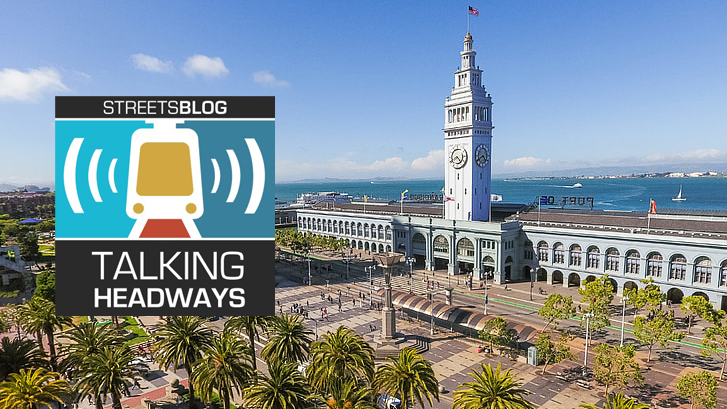This week on Talking Headways we’re joined by John King, Urban Design Critic at the SF Chronicle, to talk about his book Portal: San Francisco's Ferry Building and the Reinvention of American Cities.
We chat about the history of the Ferry Building in San Francisco — which was one of the busiest city transportation hubs in the world in the early 1900s — and how the building has evolved over time parallel to the ups and downs of cities.
Check out edited excerpt from our conversation under the audio player below. For a full, AI-generated transcription click here.
Jeff Wood: And then the highways come and the Embarcadero Freeway, kind of, as you mentioned earlier, gave residents kind of a taste of what their freeway future would look like.
John King: Yes, definitely. There are a fair number of you in here who look fairly young who would not remember the Ferry Building. I grew up when it was primarily a way to come in from UC Berkeley, to clubs in North Beach at night and then zip home. And it was kind of a fun ride. But you know, you had a double deck concrete viaduct, 60 feet high, no architectural grace, and it was wide, probably five lanes wide covering what now is the Embarcadero Boulevard where the street cars run and things like that. And so that was like a wall cutting off more than a mile of the waterfront.
And then behind it you had the Ferry Building and you had a Ferry building that was sparsely occupied and it was kind of cheap office space in various ways. And it had air conditioners sticking out of windows, the front facade looked about the way it does now, but the sides had been completely torn off and like restripped with modern band windows and things like that. And so you had this just, I mean it was literally the wrong side of the tracks and that's just how it functioned. Oh, and there was still a freight rail running north and south on the Embarcadero, which had been put in in the early 1900s and survived into the early 1980s.
Jeff Wood: So if the Ferry building and it was cut off by the Embarcadero freeway, why was it so hard then to get people to vote to tear it down?
John King: I knew this dimly, but I had forgotten about it. In 1986, San Francisco voters were asked if they wanted to tear down the Embarcadero Freeway and replace it with the surface boulevard and a little context, quote unquote, everybody hated the Embarcadero Freeway from the day it went up, you had the Chronicle saying it should be torn down. You had board of supervisors and planning commissions passing non-binding resolutions to tear it down. It was just everybody hated the Embarcadero Freeway. Then Diane Feinstein put together a plan, she got the Board of Supervisors to back her, she was mayor then, and all the regional agencies, all the agencies in this building to go along with the idea.
And so it was smooth sailing. The money was there supposedly to take down the freeway and move the traffic onto the surface streets. And voters rejected the idea by more than 60%. It was not a close election, it was just a total defeat of the idea. And a lot of it was convenience. You had people who just thought, yeah, but it's so much more convenient to ride it. And then San Francisco in 1986 was going through all sorts of development battles. And so opponents of Feinstein effectively use the argument, if we tear down the freeway, we'll just get a bunch of developers building a bunch of towers and that's what's gonna happen.
And once that election occurred, the whole question of taking down the Embarcadero Freeway seems settled once or for all until the Loma Prieta earthquake came around [in 1989].






